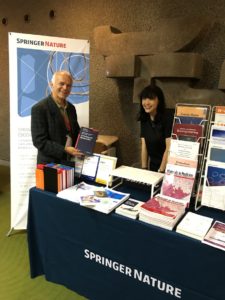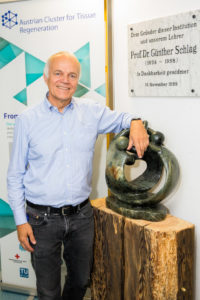
As chair of the TERMIS European chapter, what can you tell us about the Tissue Engineering and Regenerative Medicine International Society?
With more than 4000 active members worldwide, TERMIS is the most prominent society in the field of tissue engineering and regenerative medicine. It values the idea of interdisciplinary collaboration – it is not focused on only biomaterials or cells or surgical procedures, but has a profound translational character. This helps to achieve its main directive: bringing research into clinics so patients can benefit from it.
How are you implementing this translational character in your research projects?
As LBI Trauma, we are part of a broad spectrum of projects in the field of regenerative medicine. Among the 90 people working at the institute there are chemists, biochemists, physicians, veterinarians, physicists, biomedical and electrical engineers – it allows us to get a full view on any research question and its possible solutions. As central trauma research organization of the Austrian Workers’ Compensation Board AUVA there is a close collaboration with the Austrian trauma clinics. Projects are aimed at current clinical needs – we even look for new research questions by open science approaches – and new findings find their way into the clinics as soon as possible.
What are your current research highlights?
At the moment we have many novel approaches for scaffold materials. Silk for example, is treated with a new method to deplete its immunoreactive sericin layer but leave the exceptional stability of its fibroin core intake. We use it to form conduits to bridge peripheral nerve defects or as anterior crucial ligament replacement, with excellent results. On the cartilage sector we found a way to make decellularized articular cartilage accessible to cells via laser engraving. The institute also has a strong intensive care research section which is a major player in sepsis research worldwide.
Can you tell us about the Springer Reference book series “Tissue Engineering and Regeneration”?

It takes time and effort to write high quality scientific books, and by the time you have them lying on your desk they are practically outdated. This is why I am happy about Springer now offering updateable reference book series that can be accessed online or printed on demand. It fits the fast pace of scientific progress as well as the way we work and look up information in a digital age.
The Tissue Engineering and Regeneration Reference Series is designed to be the premier scientific and updatable information source in the field. The books cover the biological basis of tissue regeneration as well as the current state-of-the-art in tissue engineering of specific tissues and organs. Our advisory board contains the Who’s Who of tissue regeneration research and we are always open for new input and collaborations.
I always like to quote ‘Art is I, Science is We’
What role did TERMIS play in creating the books?
It is important for me to highlight that this is a joint project of TERMIS and Springer. The TERMIS community made this project possible by giving valuable scientific contributions and input. Springer kindly agreed to my proposal of making the books freely accessible for TERMIS members, as I felt like we cannot charge them for accessing what is in fact the work of all of us. I always like to quote “Art is I, Science is We”.
 Prof. Heinz Redl is Director of the Ludwig Boltzmann Institute of Experimental and Clinical Traumatology within the main trauma research center of AUVA representing 7 trauma and 4 rehabilitation centers, coordinator of the Austrian Cluster for Tissue Regeneration and Associated Professor at the Technical University Vienna, Institute for Chemical Engineering. He is/has been member/officer of several societies, e.g. board of TERMIS, president ESS and editorial boards (e.g. Tissue Engineering, Journal of Tissue Engineering and Regenerative Medicine, European Journal of Trauma and Emergency Surgery, Shock, European Cells and Materials Journal), founder of Trauma Care Consult company and consultant for multiple companies covering product registration at FDA and EMA.
Prof. Heinz Redl is Director of the Ludwig Boltzmann Institute of Experimental and Clinical Traumatology within the main trauma research center of AUVA representing 7 trauma and 4 rehabilitation centers, coordinator of the Austrian Cluster for Tissue Regeneration and Associated Professor at the Technical University Vienna, Institute for Chemical Engineering. He is/has been member/officer of several societies, e.g. board of TERMIS, president ESS and editorial boards (e.g. Tissue Engineering, Journal of Tissue Engineering and Regenerative Medicine, European Journal of Trauma and Emergency Surgery, Shock, European Cells and Materials Journal), founder of Trauma Care Consult company and consultant for multiple companies covering product registration at FDA and EMA.
He has also organized many conferences including the world congress in tissue engineering TERMIS 2012 and workshops. His expertise includes: Experience in different fields of tissue regeneration, co-developer of the fibrin sealant system (>30 years), developer of surgical devices in current clinical use and many collaborative projects with major industry partners. Prof Redl has over 380 Medline cited papers and over 10 patents. He has also participated in several European Commission projects including Expertissues, Angioscaff, Biodesign, IMCOSS, UGEN.
Comments